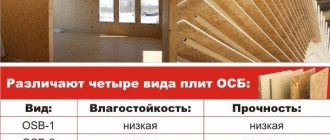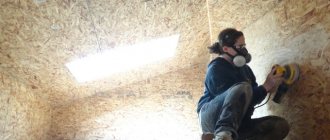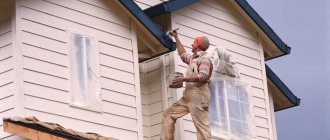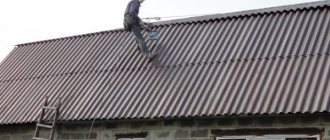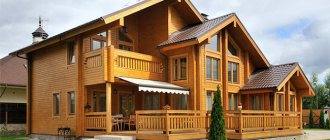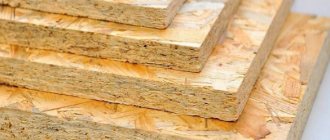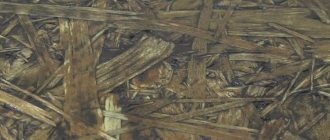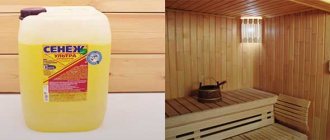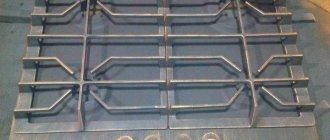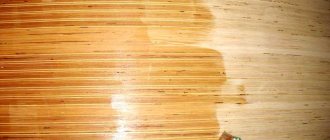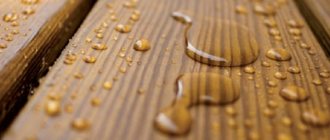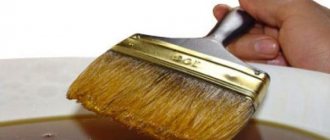[contents]In the process of construction or major repairs of residential and commercial premises, not plasterboard or plywood sheets are increasingly used, but oriented strand boards OSB or, in other words, OSB (English abbreviation OSB). It is used for frame construction, interior partitions, installation of rough or finished floors, etc. Oriented strand boards (OSB) are a composite material made from wood chips glued together using various resins, adhesives, polymers, etc. As a rule, OSB is made from aspen waste, but panels made from other materials are also found.
To protect the composite from moisture, it can be impregnated with a water-repellent composition or painted.
Depending on the characteristics of the chemical composition (impregnations, fillers, protective coatings, etc.), these products are classified into:
- OSB-1 - used for interior decoration of rooms with minimal humidity. They practically do not contain moisture-protective components.
- OSB-2 - used in rooms with normal humidity.
- OSB-3 - used for finishing walls and ceilings where there is a risk of getting wet or where there is increased background humidity.
- OSB-4 is the most durable and moisture-resistant variety. Such slabs should be purchased for the construction of load-bearing structures.
As a rule, panels of the second and third categories are used in finishing work. These are the ones we will focus on in our painting recommendations.
Expert opinion
Strebizh Viktor Fedorovich, leading construction foreman
contents In the process of construction or major repairs of residential and commercial premises, not plasterboard or plywood sheets are increasingly used, but oriented strand boards OSB or, in other words, OSB, the English abbreviation OSB. If you want to clarify something, please contact me!
Should I paint or not?
In principle, it is not necessary to paint OSB boards, but in some cases it is a necessity. Why? Painting is a way to create a dense and stable film on the surface of a material. It will perform an additional protective function, preventing the negative effects of moisture and sunlight on the wood.
In addition, some coloring compositions are distinguished by the fact that when dry they form a coating with a very dense texture. Therefore, they will not only protect the wood, but will also help smooth out the unevenness that is sometimes present on the surface of the slabs. By the way, it is for this purpose that many people use varnish compositions, since they are not satisfied with the original appearance of the finishing material.
Painting OSB boards with acrylic paint on the outside: technology, choice of paint Paint for OSB panels: which is better for interior and exterior work, technology How to paint OSB outside and inside the house: types of compositions, recommendations for selection
In addition, painting is the most cost-effective way not only to protect OSB boards from negative influences, but also to give the material a more attractive appearance. And sometimes it is the last factor that is decisive when it comes to whether OSB boards need to be painted.
Which is better: heated floors or radiators?
Warm floorBatteries
Selection of compositions for interior painting
OSB boards are made from wood waste, so any coloring composition suitable for application to a wooden base is suitable for painting them.
When choosing paint for interior work, be sure to pay attention to its environmental friendliness. The most suitable ones would be:
- Oil paints. They have a high level of viscosity, due to which they are practically not absorbed into the base. After complete drying, a very strong, but thin film is formed on the surface. The disadvantages of oil paints include long drying times and their instability to various atmospheric influences. That is why this option is used only for interior decoration;
- Alkyd paints and enamels. They are capable of penetrating deeply into the structure of slabs, filling voids, and forming a durable, moisture-resistant film on the surface. A surface painted with an alkyd composition does not require subsequent varnishing, which in turn reduces the cost of purchasing material. The coating will be durable and there will be virtually no unpleasant odor during operation. But keep in mind that alkyd paints are highly flammable;
- Clear or colored varnish. If you like the way the surface of the slabs looks, it is enough to cover them with transparent or colored varnish in several layers to provide protection from moisture and sunlight;
- Stain. Using this composition you can give the surface an aged effect. To do this, apply a thin layer of stain to the surface and then rub it with a piece of foam rubber. You can cover the surface completely, it all depends on preferences and the interior. A layer of varnish must be applied over the stain;
- Latex paint. This is a water-based composition with the addition of a synthetic rubber polymer. It can be used for interior decoration only if the walls are sheathed with OSB-3. It has the following advantages: moisture resistance, additional thermal insulation, cost-effectiveness due to the possibility of uniform distribution in a thin layer, short drying period, and safety for health. As for the disadvantages - not resistant to low temperatures, high cost. Also, the surface is prone to the formation of mold and fungi, and therefore requires additional impregnation. A thin layer of paint will not hide the characteristic texture of the slabs;
- Glazing azure. This is a water-based glazing composition that, after drying, forms a transparent or translucent film on the surface. The thickness of the coating is minimal, so it does not crack or peel over time. The use of such azure will preserve the structure of the slabs and give them an interesting shade.
What to consider when choosing paint
When selecting paint, it is necessary to take into account the characteristics of the building material.
- Adhesive characteristics of the dye and the OSB it covers. Some paints and varnishes (paint and varnish materials) interact poorly with OSB due to the presence of resins in the composition, which do not allow the paint mixture to pass into the material well. It is better not to paint OSB with water-based paint or other water-soluble mixtures. It is better to use acrylic or polymer-based paints.
- Factuality of OSB. The greater the unevenness of the slab, the greater the paint consumption. Uneven textures require more careful preparation.
- OSB age. If they have not been cleaned and have been left outdoors exposed to sunlight and precipitation for more than a year, there may be problems with painting. In order to paint such materials with high quality, they must first be cleaned of dirt, sanded, and treated with an antiseptic.
When choosing paint, you must also consider how the surface will be decorated, whether there is a need to preserve the texture of the slab or whether it needs to be made smooth.
The area of application of the paint and varnish material is important, since to paint the floor it is necessary to use paint compositions that are more resistant to mechanical stress.
There are a number of recommendations that should be taken into account when selecting a dye.
Expert opinion
Strebizh Viktor Fedorovich, leading construction foreman
They can be used for renovations in a house, on the floor, and if we are talking about a whole house-house, then it is too expensive both financially and in terms of time costs. If you want to clarify something, please contact me!
The most commonly used paints for painting OSB outside the house
Water-based paint
The cheapest paint in terms of cost, and the easiest to apply. The basic basis of the paint is water; the structure layer itself is formed due to a small proportion of acrylics introduced into the composition. The material does not burn, it has no odor, and after drying, a thin polymer film forms on the surface of the facade.
Water-dispersion relief paint
In terms of composition, water-dispersion paint consists of water, a higher proportion of acrylic compared to water-based compositions, and additives. Most often, manufacturers use marble dust or chips with a fraction of 1-2 mm as additives. The cost of water-dispersion paint is higher than that of water-based paint. However, the higher price is compensated by obtaining a unique relief coating on the surface of the facade, which allows you to get a finished appearance. This point is very important, since using classic OSB-3 or OSB-4 boards, on the surface of which there is a relief of wood chips, a layer of facade relief paint can hide all this “ugliness”. The result is a surface very similar to the once popular “fur coat”, only with smaller specks.
As a standard, water-based and water-dispersion relief paints are produced in snow-white color. To obtain the required color or shade, the paint is tinted by adding liquid tint to it before applying it to the surface. Also, when purchasing paint in a specialized store, you can ask that it be tinted to the selected color using a special electronic tinting machine.
Water-dispersion paint does not always contain additives. There are its varieties in which there is no relief filler. In terms of resistance to moisture and durability, such paint is superior to water-based paint, but after its application the same uniform glossy layer is obtained, that is, without relief.
Alkyd paint
The cost of the material is average, but higher than that of previous paints. The composition of the paint basically consists of resins of plant origin, to liquefy which weak acids are used. After applying OSB to the surface and drying, an almost waterproof thin layer is formed, which is highly resistant to sunlight and temperature drops to -30...-35 degrees.
It cannot be said that alkyd facade paint is widely popular. It has two significant drawbacks. OSB is a material based on wood waste. Wood is flammable. Alkyd paints are also very flammable. You will either need to be very vigilant and constantly observe fire safety regulations, or before painting, thoroughly saturate the OSB surface with expensive emulsions and compounds that prevent wood from burning.
The second disadvantage of alkyd paints is related to their application. The surface of the OSB boards must be perfectly dried, which can be difficult when it comes to painting the facade. That is, you need to be prepared for the fact that you will have to wait 1-2 weeks in warm, rainless weather for the facade to completely dry out.
Oil paints
The cost is average. The basic composition of the material is based on drying oil. Today, it is used extremely rarely for painting OSB facades. This is due to the following disadvantages:
- the paint is toxic;
- there are a lot of stains, smudges and drops on the surface;
- takes a long time to dry and must be applied to a perfectly dry surface;
- After a few years, with cyclical freezing and thawing, as well as under the influence of sunlight, the paint on the surface of the OSB begins to crack and fall off.
Latex paints
The price of latex paints is higher than all previously described materials. Latex paint consists of water, a large proportion of acrylic resin, color and a polymer latex additive, which is based on silicone, vinyl or polyvinyl. Latex paints in most cases come pre-set with a specific color or tone of color. When painting an OSB surface, you can get both a glossy, flat surface and a relief surface that imitates a “fur coat” or “rain”, onto which the background was applied with a spray gun. Considering that the composition does not contain additives in the form of marble dust, special large-porous sponge rollers are used to obtain a relief surface.
How to paint an OSB board on a facade: choice of materials and painting technology
- If necessary, the stain is diluted with a solvent or acetone.
- Apply stain to the slab with a paint brush, spray gun, or rub in with a foam swab (rag).
- Allow the composition to dry thoroughly. This will take no more than 10 minutes.
- The dried stain-painted surface must be fixed with polyurethane primer and wait for it to dry completely.
Surface preparation
All preparatory work is carried out after the installation of the slab structure, since after installation it is still necessary to adjust the joints and sand down any irregularities.
Grinding
OSB-3 and OSB-4 boards are sanded especially deeply, since the protective varnish and wax coating must be removed from them.
Purging
After sanding, the joints of the plates must be blown out with a compressor with a thin long hose. The procedure will remove sanding dust or possible dirt residues in hard-to-reach places. If there is no compressor, it can be replaced with a long-haired brush.
putty
OSB of any type always has small irregularities and depressions that need to be puttied. The putty must have an oil-adhesive composition. It fills voids and dents from self-tapping screws. Afterwards, the slabs are additionally sanded, but not earlier than 1-2 days after puttying.
It is not recommended to putty OSB at the joints and along the seams, since it will not be possible to disguise them, and after painting these areas will still be visible.
Primer
It is best to prime OSB with acrylic or acrylic-polyurethane water-based varnish. The composition must first be diluted with water in a ratio of 1 to 10. Alkyd varnish can also be diluted with white spirit. Apply the composition carefully and slowly so that it is well absorbed into the surface.
Additionally, the façade of the building can be coated with protective solutions against fungus, rot, mold, for water repellency or against fire. To save your budget, you can use universal complex products that include 3 protective emulsions at once.
Technologies for painting OSB with various types of paints
Surface preparation
Regardless of what type of paint was chosen, the preparation of the surface of the facade made of OSB boards is always the same.
1 . The surface must be dried. If we are talking about a facade, then you need to wait 5-7 days in warm weather for the OSB to dry well.
2. The entire surface of the OSB is passed with a grinding machine, onto which medium-grain sandpaper is installed. Particular attention is paid to the joints between the slabs. If there are too rough areas somewhere, then initially they are sanded with coarse-grained sandpaper, and then fine-grained sandpaper is used.
Processing with a grinding machine.
3. After sanding, all seams between the plates must be blown out using a long hose connected to a compressor. If this is not possible, then the seams must be carefully swept with a sweeping brush.
4. The seams between the OST slabs are sealed with a special putty. If it is not possible to buy wood putty, then the seams can be sealed with simply liquid nails. If somewhere there is a seam between the plates of more than 5 mm, then such a gap is sealed with wood putty, to which 1/4 of the total volume of large sawdust is added before applying it. In this case, sawdust will serve as reinforcement and filler, and will prevent further destruction of the putty in large seams. Instead of sawdust, you can use fine synthetic fiber.
Alignment of joints and puttying.
5. Having filled all the seams between the sheets and, after waiting 1-2 days, the entire surface and especially the seams are sanded again with a sanding machine.
6. The entire prepared surface of the facade is treated alternately with different emulsions that increase water resistance, resistance to fungus and combustion. There are special multi-emulsions that combine several protective qualities at once.
Application of emulsion.
Applying water-based, alkyd or oil-based paint to achieve a smooth surface
Initially, the surface of the OSB boards is primed with a primer of the same color as the future finishing paint. Sometimes it is permissible to use a primer of the same color, but in a lighter tone, but not vice versa; a primer of a darker tone will not work. The primer can be applied with a wide brush, nap, felt or fine-pored sponge roller. After application, the primer should dry well, after which you can begin applying the base paint.
If the paint is too thick, then it must be diluted to a thinner consistency. In the case when water-based or water-dispersion paint is used, ordinary clean water at room temperature is used as a diluent. To dilute alkyd or oil paint, the following thinners are used: white spirit, turpentine or RS-2.
Painting OSB outside the house with water-based, alkyd or oil-based paint.
Most often, a nap roller is used to apply water-based paint to a wooden base. The length of the villi should be more than 15 mm. For alkyd paints, it is more preferable to use a roller with a felt or fine-pored foam coating. Initially, the roller is dipped into a bucket of pre-diluted paint, after which the roller is rolled out on a horizontally laid sheet of plywood or in a special plastic tray. Rolling out the roller is necessary to evenly distribute the paint over the surface of the roller.
Painting OSB outside the house. Distributing paint with a roller.
Using a rolled roller, begin to apply paint from the left corner of the wall (vice versa for left-handed people). Initially, 1 vertical strip is produced. Next, changing the degree by about 15-20 cm, lead the strip upward from the bottom of the strip. After this, the inclination of the roller is changed again and the strip is drawn down from the top. In general, the trajectory of the roller along the surface of the wall should be in the shape of the letter - W. To get the most even, smooth and uniform surface, you will need to apply at least 3 layers of paint to the OSB board. In this case, each layer must dry completely before applying the next one.
Application of embossed latex or alkyd water-dispersion paint on OSB
Painting with these paints also begins with priming. It must be said that there are a lot of varieties and manufacturers of these paints, and in order to get a high-quality painted surface, you need to purchase the primer that the manufacturer himself recommends in the instructions for a specific paint. For example, if silicone paint is used, then the primer should also be silicone-based from the same manufacturer. Otherwise, it will not be possible to achieve proper adhesion of the paint to the primer.
Applying relief paint to a façade made of OSB sheets.
Under relief water-dispersion paint, the primer is applied with a fleecy roller, and under latex relief paint, the primer is applied with a wide flat brush. After the primer layer has dried, begin applying relief paint. The paint is not diluted, but used in the thick consistency in which it is. Paint is applied to the surface of the primed OSB using a spatula with a blade width of 40-60 cm. In essence, the surface is puttyed without much removal. Smudges, drops and stains are allowed. Having thus applied a 1.5-2 mm thick layer of relief paint, then take a dry, large-pored sponge roller, which is passed in a zigzag pattern in the shape of the letter W over the entire treated surface. The force of pressure on the roller will directly influence the layer of paint and the markings in the structure of the relief.
Painted wall with relief.
What paint is suitable
In general, it is believed that in order to process particle boards, the paint must have a polymer base and an ordinary water emulsion is not suitable for this. Compositions containing acrylates will make the coating amenable to washing and cleaning, and if it is necessary to provide additional protection from moisture, materials based on latex, alkyd or polyurethane are used.
The specificity of OSB staining lies in their strongly pronounced texture. The paint spreads on the edges of the protruding chips and therefore for a continuous coating it may require two or even three applications in a row. However, sometimes this is even beneficial: the use of tinted compounds in several layers allows you to achieve interesting visual effects.
Expert opinion
Strebizh Viktor Fedorovich, leading construction foreman
Today you will learn why it is important to choose the right composition for interior and exterior work, as well as how to carry out the work yourself so that the finish retains its appearance for many years. If you want to clarify something, please contact me!
Preparation and application of paint
When painting OSB, it is better to apply paints and varnishes in two layers. The first is diluted with the addition of 10–15% of the appropriate solvent. This can be water, acetone or petroleum solvents, depending on the composition of the paint. The second layer is applied with solid paint.
When painting OSB, it is very important to adhere to the strategy of applying many thin layers, no matter how great the temptation to smooth out the rough edges with a thick layer of thick paint. In the latter case, uneven absorption and, as a result, paint peeling is possible, especially when working with class 3 and 4 boards.
Maintaining the appearance and structure
Many people like the unusual texture of OSB boards, and they do not want to cover the natural pattern of wood chips. Whereas they paint OSB boards, which have an unusual appearance, in order to both preserve the beauty of the wooden structure and protect the house from bad weather.
On video: methods of decorative coating of OSB panels.
When deciding how to cover an uneven surface, consider clear paint with a UV filter. This varnish is created on the basis of alkyd resins; its components reliably protect the slab from external aggressive influences. The varnish gives a matte tint to the chipboard and preserves the pattern and structure.
A matte or semi-matte acrylic varnish for exterior use will give a beautiful look to a painted slab. It is convenient to apply, and to obtain a better effect, you can treat the surface of the OSB board with water-based impregnation.
How to treat the surface → Room decoration → How to choose the right paint → Surface treatment technologies → Leveling and finishing the walls → Selecting and applying a primer → Removal from the surface → Stretch ceilings and technologies → Reviews and testimonials
How to paint OSB indoors and outdoors (outdoors)
Stain is used to preserve the natural pattern and protect the wood from moisture and ultraviolet radiation. There are five main colors available:
Expert opinion
Strebizh Viktor Fedorovich, leading construction foreman
Painting is needed even if OSB is used for the primary finishing of the exterior of the building with the fastening of lining, siding or sheet insulation. If you want to clarify something, please contact me!
Choosing a method for painting OSB boards
The choice of coloring method is determined by the achievement of the final result. You need to decide whether the coating should protect the surface or whether it will simply serve as a decoration element?
You can paint the surface using a spray gun. The layers turn out even. Plus, painting takes minimal time. However, the consumption of paintwork materials increases, and the spray guns themselves cannot be called cheap.
You can also paint with a brush, but this process is more difficult and takes more time. Using a hand paint roller speeds up the process and is suitable for a variety of mixtures and large areas.
Using a hand paint roller speeds up the process and is suitable for a variety of mixtures and large areas.
Transparent coatings
A very thin type of paint based on alkyds and acrylates. Azure or glazing compounds are another name for this variety. The use of glaze emphasizes the noble relief of wood, giving it protection from ultraviolet radiation. And by playing with different shades, you can get an unusual decor.
The use of glaze emphasizes the noble relief of wood, giving it protection from ultraviolet radiation.
Covering enamels
This variety attracts attention because it can equally be used to paint both external and internal walls. Wide choice of colors, increased performance indicators.
Wide choice of colors, increased performance indicators.
Tinting OSB panels
Stain is an excellent material for tinting OSB boards. To achieve the required shade, it is diluted with a solvent. The stain is applied mechanically or manually. Then let it dry. If the paint has been diluted, the drying time is reduced to 5 minutes. The composition can also be rubbed in with a sponge, saturating the surface.
Using this painting method, you can create the illusion of antiquity by adding patina to the composition, the remnants of which are removed with a sponge after drying. You can secure the result by coating the painted wood with varnish.
Using this painting method you can create the illusion of antiquity.
Fire protection of OSB boards
How to paint OSB to protect the surface from fire? Special formulations, ready for use, which already have fire and bio protective properties. The basis of water-dispersed compositions is polyvinyl acetate:
- The solvent in it is not flammable;
- Special additives neutralize pathogens and bacteria. The treated surface is not afraid of either insects or mold;
- Other additives are responsible for the fire-resistant properties of the paint. In this case, the components penetrate inside the slabs and provide protection not only to the outer layer, but also to the inner one.
Such compositions are related to PVA paints. At the same time, they have high decorative characteristics.
Special additives neutralize pathogens and bacteria.
How and with what to paint OSB boards outside and inside the house.
- Acrylic paint. A modern option that has already become popular is painting the OSB boards on the facade of the house with a special acrylic composition for exterior work. Acrylic paint, consisting of polymers, water and a dye - color, creates a durable film on the surface after painting. This composition fits well on an uneven surface, so you can choose this option for painting the outside of OSB boards. Acrylic paints are widely represented on the building materials market: beautiful rich colors, the ability to choose matte and glossy compositions will help turn your house into a miracle mansion. Advantages of acrylic paint: does not spread, fits well on porous surfaces;
- dries quickly;
- does not fade under the sun;
- has high vapor and water permeability;
- resistant to temperature changes and various weather conditions.
